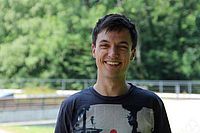Dr. Stephan Stadler
Project leader

Max Planck Research Group Leader
Max Planck Instutute for Mathematics Bonn
E-mail: stadler(at)mpim-bonn.mpg.de
Homepage: https://people.mpim-bonn.mpg.de/stadler/
Project
24Minimal surfaces in metric spaces
66Minimal surfaces in metric spaces II
Publications within SPP2026
If a group Γ acts geometrically on a CAT(0) space X without 3-flats, then either X contains a Γ-periodic geodesic which does not bound a flat half-plane, or else X is a rank 2 Riemannian symmetric space, a 2-dimensional Euclidean building or non-trivially splits as a metric product. Consequently all such groups satisfy a strong form of the Tits Alternative.
Related project(s):
66Minimal surfaces in metric spaces II
This belongs to a series of papers motivated by Ballmann's Higher Rank Rigidity Conjecture. We prove the following. Let X be a CAT(0) space with a geometric group action. Suppose that every geodesic in X lies in an n-flat, n≥2. If X contains a periodic n-flat which does not bound a flat (n+1)-half-space, then X is a Riemannian symmetric space, a Euclidean building or non-trivially splits as a metric product. This generalizes the Higher Rank Rigidity Theorem for Hadamard manifolds with geometric group actions.
Related project(s):
66Minimal surfaces in metric spaces II
A CAT(0) space has rank at least n if every geodesic lies in an n-flat. Ballmann's Higher Rank Rigidity Conjecture predicts that a CAT(0) space of rank at least 2 with a geometric group action is rigid -- isometric to a Riemannian symmetric space, a Euclidean building, or splits as a metric product. This paper is the first in a series motivated by Ballmann's conjecture. Here we prove that a CAT(0) space of rank at least n≥2 is rigid if it contains a periodic n-flat and its Tits boundary has dimension (n−1). This does not require a geometric group action. The result relies essentially on the study of flats which do not bound flat half-spaces -- so-called Morse flats. We show that the Tits boundary ∂TF of a periodic Morse n-flat F contains a regular point -- a point with a Tits-neighborhood entirely contained in ∂TF. More precisely, we show that the set of singular points in ∂TF can be covered by finitely many round spheres of positive codimension.
Related project(s):
66Minimal surfaces in metric spaces II
This is the second in a two part series of papers concerning Morse quasiflats - higher dimensional analogs of Morse quasigeodesics. Our focus here is on their asymptotic structure. In metric spaces with convex geodesic bicombings, we prove asymptotic conicality, uniqueness of tangent cones at infinity and Euclidean volume growth rigidity for Morse quasiflats. Moreover, we provide some immediate consequences.
Related project(s):
24Minimal surfaces in metric spaces66Minimal surfaces in metric spaces II
This is the first in a series of papers concerned with Morse quasiflats, which are a generalization of Morse quasigeodesics to arbitrary dimension. In this paper we introduce a number of alternative definitions, and under appropriate assumptions on the ambient space we show that they are equivalent and quasi-isometry invariant; we also give a variety of examples. The second paper proves that Morse quasiflats are asymptotically conical and have canonically defined Tits boundaries; it also gives some first applications.
Related project(s):
24Minimal surfaces in metric spaces66Minimal surfaces in metric spaces II
We prove that a topological 4-manifold of globally non-positive curvature is homeomorphic to Euclidean space.
Related project(s):
24Minimal surfaces in metric spaces66Minimal surfaces in metric spaces II
We show that closed subsets with vanishing first homology in two-dimensional spaces inherit the upper curvature bound from their ambient spaces and discuss topological applications.
Related project(s):
24Minimal surfaces in metric spaces66Minimal surfaces in metric spaces II
We show that any space with a positive upper curvature bound has in a small neighborhood of any point a closely related metric with a negative upper curvature bound.
| Journal | Trans. Amer. Math. Soc. |
| Link to preprint version | |
| Link to published version |
Related project(s):
24Minimal surfaces in metric spaces66Minimal surfaces in metric spaces II
We prove that in two dimensions the synthetic notions of lower bounds on sectional and on Ricci curvature coincide.
| Journal | J. Eur. Math. Soc. |
| Volume | Online first article |
| Link to preprint version |
Related project(s):
24Minimal surfaces in metric spaces66Minimal surfaces in metric spaces II
We show that the class of CAT(0) spaces is closed under suitable conformal changes. In particular, any CAT(0) space admits a large variety of non-trivial deformations.
| Journal | Math. Ann. |
| Link to preprint version | |
| Link to published version |
Related project(s):
24Minimal surfaces in metric spaces
A surface which does not admit a length nonincreasing deformation is called metric minimizing. We show that metric minimizing surfaces in CAT(0) spaces are locally CAT(0) with respect to their intrinsic metric.
| Journal | Geom. Topol. |
| Link to preprint version | |
| Link to published version |
Related project(s):
24Minimal surfaces in metric spaces
We prove that a minimal disc in a CAT(0) space is a local embedding away from a finite set of "branch points". On the way we establish several basic properties of minimal surfaces: monotonicity of area densities, density bounds, limit theorems and the existence of tangent maps.
As an application, we prove Fary-Milnor's theorem in the CAT(0) setting.
| Journal | J. Eur. Math. Soc. |
| Link to preprint version | |
| Link to published version |
Related project(s):
24Minimal surfaces in metric spaces
We prove an analog of Schoen-Yau univalentness theorem for saddle maps between discs.
| Journal | Geom. Dedicata |
| Link to preprint version | |
| Link to published version |
Related project(s):
24Minimal surfaces in metric spaces

